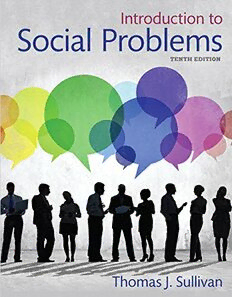Table Of ContentTENTH EDITION
Introduction to Social
Problems
A01_SULL6462_10_SE_A01.indd 1 21/11/14 6:19 pm
This page intentionally left blank
A01_SULL6462_10_SE_A01.indd 21 11/12/14 2:23 pm
Introduction to Social
Problems
Thomas J. Sullivan
Professor Emeritus
Northern Michigan University
TENTH EDITION
Boston Columbus Indianapolis New York San Francisco Amsterdam
Cape Town Dubai London Madrid Milan Munich Paris Montréal Toronto
Delhi Mexico City São Paulo Sydney Hong Kong Seoul Singapore Taipei Tokyo
A01_SULL6462_10_SE_A01.indd 3 21/11/14 6:19 pm
Publisher: Charlyce Jones Owen Procurement Specialist: Diane Peirano
Editorial Assistant: Maureen Diana Art Director: Maria Lange
Product Marketing Manager: Tricia Murphy Cover Designer: Kristina Mose-Libon
Field Marketing Manager: Brittany Pogue-Mohammed Project Manager, Digital Studio: Claudine Bellanton
Program Manager: Seanna Breen Full-Service Project Management: Bruce Hobart, SPi-Global
Production Team Lead: Denise Forlow Printer/Binder: Courier/Kendallville
Project Manager: Manuel Echevarria Cover Printer: Courier/Kendallville
Senior Operations Supervisor: Mary Fischer Text Font: Palatino LT Pro 9.5/13
Acknowledgements of third party content appear on page 461, which constitutes an extension of this copyright page.
Copyright © 2016, 2012, 2009 by Pearson Education, Inc. or its affiliates. All Rights Reserved. Printed in the United States
of America. This publication is protected by copyright, and permission should be obtained from the publisher prior to any
prohibited reproduction, storage in a retrieval system, or transmission in any form or by any means, electronic, mechanical,
photocopying, recording, or otherwise. For information regarding permissions, request forms and the appropriate contacts
within the Pearson Education Global Rights & Permissions department, please visit www.pearsoned.com/permissions/.
PEARSON and ALWAYS LEARNING are exclusive trademarks in the U.S. and/or other countries owned by Pearson Education, Inc.
or its affiliates.
Unless otherwise indicated herein, any third-party trademarks that may appear in this work are the property of their respective
owners and any references to third-party trademarks, logos or other trade dress are for demonstrative or descriptive purposes
only. Such references are not intended to imply any sponsorship, endorsement, authorization, or promotion of Pearson’s prod-
ucts by the owners of such marks, or any relationship between the owner and Pearson Education, Inc. or its affiliates, authors,
licensees or distributors.
Library of Congress Cataloging-in-Publication Data
Sullivan, Thomas J.,
Introduction to social problems / Thomas J. Sullivan, Professor
Emeritus Northern Michigan University. — Tenth edition.
pages cm
ISBN 978-0-205-89646-2 (alk. paper) -- ISBN 0-205-89646-4 (alk. paper)
1. Social problems—United States. 2. United States—Social conditions. 3. United States—Social policy.
I. Title.
HN28.S92 2015
361.10973—dc23
2014042090
10 9 8 7 6 5 4 3 2 1
Student Edition:
ISBN-10: 0-205-89646-4
ISBN-13: 978-0-205-89646-2
Books à la Carte
ISBN-10: 0-13-405456-3
ISBN-13: 978-0-13-405456-8
A01_SULL6462_10_SE_A01.indd 4 21/11/14 6:19 pm
For Nancy
A01_SULL6462_10_SE_A01.indd 5 21/11/14 6:19 pm
This page intentionally left blank
A01_SULL6462_10_SE_A01.indd 21 11/12/14 2:23 pm
Brief Contents
1 Approaches to the Study 9 Age and Social Inequality 240
of Social Problems 1
10 Crime and Delinquency 263
2 Concentration of Power:
Economic and Political Institutions 26 11 Alcohol and Other Drugs 293
3 Family-Related Problems 57 12 Prostitution, Pornography,
and the Sex Trade 321
4 Health and Illness 87
13 Population Growth
5 Education, Science, and Technology 121 and Urbanization 344
6 Poverty 152 14 Environmental Problems 374
7 Race and Ethnic Relations 179 15 Violence, War, and Terrorism 403
8 Gender, Sexual Orientation,
and Social Inequality 207
vii
A01_SULL6462_10_SE_A01.indd 7 21/11/14 6:19 pm
This page intentionally left blank
A01_SULL6462_10_SE_A01.indd 21 11/12/14 2:23 pm
Contents
Preface xiii inteRnAtionAl peRspectiVes: Global economic
About the Author xviii concentration 36
Perspectives on the Concentration of Power 37
1 Approaches to the Study of Social The Functionalist Perspective 37
Problems 1 The Conflict Perspective 38
Is There a Power Elite in the United States? 38
What Is a Social Problem? 3
Applied ReseARch: corporate concentration
Personal Troubles, Public Issues,
and Globalization of the Media 39
and Social Problems 3
The World Economic System 42
The Social Context of Social Problems 4
Problems Created by the Concentration of Power 43
The Sociological Imagination 6
Effects on Competition 43
Theoretical Perspectives on Social Problems 7
Conflict between Societal and Corporate Goals 44
The Functionalist Perspective 7
Threats to Democratic Institutions 44
The Conflict Perspective 9
The Dwindling of Unions 45
The Interactionist Perspective 10
Worker Dislocation and Unemployment 45
Using the Theoretical Perspectives 12
Abuse of Government Authority 48
Constructing Social Problems:
The Mass Media and Other Influences 12 Future Prospects 49
Research on Social Problems 13 Reducing Government and Deficits 49
The Scientific Method 14 Government Reorganization 49
Collective Action by Citizens 50
Applied ReseARch: Untangling Myths
and Facts about social problems 14 The Globalization of Labor Rights 52
Economic Reorganization 52
Conducting Research 15
policy issUes: What Role should Government
Values, Interest Groups, and Objectivity 16
play in the Global economy? 54
Assessing Data: Problems and Pitfalls 17
Future Prospects: Solving Social Problems 19 Study and Review 55
What Can We Do about Social Problems? 19
The Interplay of Social Policy and Research 20 3 Family-Related Problems 57
Who Provides Solutions? 20
The Family in Society 58
policy issUes: domestic Violence:
Myths And FActs: About the Family 59
how to intervene? 21
The Functionalist Perspective 59
Should We Solve the Problem? 23
Applied ReseARch: child care: problem
inteRnAtionAl peRspectiVes: social problems
or solution? 62
in other societies 23
The Conflict Perspective 63
Study and Review 24
The Interactionist Perspective 64
2 Concentration of Power: Economic Attitudes Toward Marriage and Family 64
Divorce 66
and Political Institutions 26
The Divorce Rate 67
Types of Economic Systems 27 Who Gets Divorced? 68
Myths And FActs: About Business The Effects of Divorce 69
and Government 28 Diverse Family Lifestyles 71
Capitalism 28 Dual-Earner Families 71
Socialism 29 Singlehood 73
Mixed Economies 29 Cohabitation 73
The Concentration of Economic and Political Power 30 Single Parenthood 74
The Corporate Economy 30 policy issUes: Are Gay and lesbian Families
Unionization 31 “Families”? 75
Big Government 34 A Global Perspective 77
ix
A01_SULL6462_10_SE_A01.indd 9 21/11/14 6:19 pm

